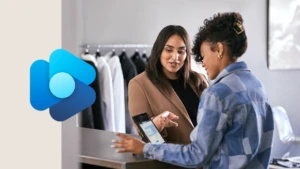
Building Personal Relationships through Technology
Over the last decade, the retail industry has undergone a massive transformation. The proliferation of e-commerce expanded customer choice, the rise of social media changed how people gather product details, and the expansion of smartphones placed an unlimited supply of information at our fingertips. All of this means that customer expectations are changing—rapidly. Whether we’re multitasking from our couch or comparing product specs in store, this transformation has fundamentally shifted how we view shopping as an experience.
Today, shopping is not just the act of acquiring goods; it has become a prominent pastime. In a 2016 survey of nearly 60,000 18- to 24-year-olds, shopping was the third most popular pastime (67%) behind socializing with friends (77%) and listening to music (70%); it was ranked above watching TV (60%), going to the gym (41%), and partying (37%).¹ And over the last decade, consumer-spending growth in experiential categories (like travel and dining out) has outpaced retail growth averages.²
What this means is that what consumers are looking for—what they’re ultimately buying—is not just a product, but an experience. It’s not just the food, it’s the ambience of the restaurant. It’s not just a new TV, it’s the comfort of knowing that the store will replace it without hassle should it break. It’s not just the shoes, it’s the ability to make sure your size is in stock before you go to the store and try them on.
This is not to suggest that producing amazing products isn’t important—with an internet-worth of options, the benchmark for great products is higher than ever—but to suggest that businesses must redefine what their product actually is. The product that a customer purchases is more than just the “goods” themselves; it’s the end-to-end experience of discovering, acquiring, and using the product. It’s the ability to return it—easily—if it doesn’t work out. It’s the sum of every interaction a customer has with a brand; it’s the premium a customer is willing to pay a trusted retailer when they could get the product elsewhere for less. At the end of the day, retailers must design every customer touchpoint with the same level of intention and care that they do their products—because to the customer, they’re equally important.
These new expectations have created many challenges for retailers, and the industry has had its share of casualties. But smart retailers evolved. A new generation of technology-enabled retail experiences and business models are pushing the industry forward. This evolution is not a trend, but rather the new reality of retail.
In the past, retailers existed in two genres: small local shops and big-box retailers. Where the shops were often locally owned and provided more personalized experiences, big-box retailers had the most options. In 2006, the market cap of today’s largest eight brick-and-mortar retailers was roughly $400 billion, while Amazon was only valued at $17.5 billion. As e-commerce grew, it offered customers more options at lower prices, leaving big-box retailers in an un-needed middle position: having neither the best variety, nor the personal service of a local store. Today, Amazon’s market cap surpasses the eight largest retailers combined.³
As retailers fulfill the need for options through e-commerce platforms, many are re-evaluating their in-store experiences, trying to replicate the feel, service, and personalization of small local shops by providing varied services for their customers. These include food and beverages that blend shopping into a fun social activity with friends, fitness classes that bring together a community of likeminded people, and one-on-one in-store tailoring consults. These types of experiences are more than just personalized; they build relationships that are personal. To illustrate the difference: anyone can order a custom-tailored suit online, but not everyone has “a suit guy.” And when you have a suit guy, he’s going to be your first call the next time you need some new attire.
These types of in-store experiences are a great start to building personal relationships with customers, but they’re just one piece of a complex system. Data and technology have long made personalized experiences possible—for example, recommendation engines that show a customer products “picked just for you”—but today, customers crave more. They don’t just want personalization; they want a personal relationship with a brand.
For better or worse, customers expect brands to behave like people; they want to be able to have an ongoing relationship with a brand, not one that restarts at every interaction. Whenever they interact with a new sales associate or support agent, they expect that individual to understand their past relationship with the brand. They want a continuous conversation, not fragmented discussions.
Like prior personalization movements, this evolution will be largely enabled through unified data. No longer just a buzzword, omni-channel solutions enable retailers to aggregate data across every customer touchpoint. Beyond the platitudes of “allowing customers to engage anytime, anywhere, on any device, and any platform,” omni-channel does something even more simple and elegant: it provides continuity in the relationship between a customer and a brand.
Historically, customers have had ongoing relationships with brands—over multiple purchases, store visits, and interactions with store employees or support staff. However, the continuity in this relationship was one-sided. Customers remembered every interaction with a brand, but due to siloed data and systems, retailers weren’t able to tell when a customer last contacted them, and for what. With omni-channel solutions, retailers can aggregate data across every customer touchpoint, providing employees with the necessary information to make each conversation a continuation of the last—the way a true relationship with a peer would evolve.
No conversation around retail would be complete without discussing the amazing impact that augmented reality (AR) and mixed reality (MR) are poised to have on the industry. AR/MR technology is already finding its way into retail stores, like smart mirrors and customized dressing rooms, facial-mapping technology that allows customers to “try on” beauty products, and home-furnishing apps that let customers “see” how furniture looks in their spaces. But the best is yet to come. As this technology becomes more ubiquitous, it will empower retailers to provide better, more personal experiences.
Customer expectations shift rapidly, and retailers must stay ahead of the technology curve in order to build relationships that will ultimately grow their business. At Microsoft, we’re building technology to empower retailers to do more. Through Dynamics 365, we’re giving businesses of all types the power to transform. Our retail solution allows retailers to create amazing customer experiences, empower their employees, optimize operations, and transform their products.
From augmented and mixed reality to intelligent bots, we continue to invest in new technology to empower retailers and unlock new, amazing opportunities. As we help our retailer partners meet today’s evolving challenges, we’re paving the way for a new generation of retail that will reshape possibilities and redefine expectations.
We’re excited to showcase our latest capabilities at this year’s NRF. If you’re attending, please visit us at booth 2803. And for those who can’t attend, you can learn more about Dynamics 365 and the future of unified commerce at dynamics365.com.




